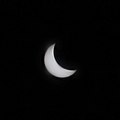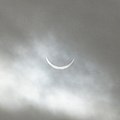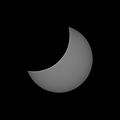Solar eclipse of March 20, 2015
| Solar eclipse of March 20, 2015 | |
|---|---|
 From Longyearbyen, Svalbard | |
| Type of eclipse | |
| Nature | Total |
| Gamma | 0.9454 |
| Magnitude | 1.0445 |
| Maximum eclipse | |
| Duration | 167 s (2 min 47 s) |
| Coordinates | 64°24′N 6°36′W / 64.4°N 6.6°W |
| Max. width of band | 463 km (288 mi) |
| Times (UTC) | |
| Greatest eclipse | 9:46:47 |
| References | |
| Saros | 120 (61 of 71) |
| Catalog # (SE5000) | 9541 |
A total solar eclipse occurred at the Moon's descending node of orbit on Friday, March 20, 2015,[1] with a magnitude of 1.0445. A solar eclipse occurs when the Moon passes between Earth and the Sun, thereby totally or partly obscuring the image of the Sun for a viewer on Earth. A total solar eclipse occurs when the Moon's apparent diameter is larger than the Sun's, blocking all direct sunlight, turning day into darkness. Totality occurs in a narrow path across Earth's surface, with a partial solar eclipse visible over a surrounding region thousands of kilometres wide. Occurring only about 14 hours after perigee (on March 19, 2015, at 19:40 UTC), the Moon's apparent diameter was larger.[2]
Totality was visible in the Faroe Islands and Svalbard. A partial eclipse was visible for parts of Greenland, Europe, North Africa, Central Asia, and western Russia. This total solar eclipse is notable in that the path of totality passed over the North Pole.
The longest duration of totality was 2 minutes and 47 seconds off the coast of the Faroe Islands. It was the last total solar eclipse visible in Europe until the eclipse of August 12, 2026.[3]
Event
[edit]The solar eclipse began at 08:30 GMT in northwest Europe, and moved towards the northeast, but was still in northern Europe. It was most visible from the North Atlantic and Arctic Oceans, Greenland, Iceland, Ireland, the United Kingdom, Faroe Islands, northern Norway and Murmansk Oblast. The shadow began its pass off the south coast of Greenland. It then moved to the northeast, passing between Iceland and the United Kingdom before moving over the Faroe Islands and the northernmost islands of Norway. The shadow of the eclipse was visible in varying degrees all over Europe.[4] For example, London experienced an 86.8% partial solar eclipse while points north of the Faroe Islands in the Norwegian Sea saw a complete solar eclipse.[5] Three chartered airliners flew above the clouds, giving passengers a slightly prolonged view.[6]
The eclipse was observed at radio frequencies at the Metsähovi Radio Observatory, Finland, where a partial eclipse was seen.[7] The eclipse was also observed by meteorological satellite Meteosat-10.[8][9]
Impact
[edit]This section needs to be updated. (May 2017) |
The European Union has a solar power output of about 90 gigawatts and production could have been temporarily decreased by up to 34 GW of that dependent on the clarity of the sky. In actuality the dip was less than expected, with a 13 GW drop in Germany happening due to overcast skies.[10][11] This was the first time that an eclipse had a significant impact on the power system, and the electricity sector took measures to mitigate the impact. The power gradient (change in power) may be −400 MW/minute and +700 MW/minute. Places in Netherlands, Belgium and Denmark were 80-85% obscured.[12][13][14] The temperature drops varied greatly across Europe, with most areas having an insignificant drop in temperature due to the overcast weather, while others, like Scotland, Wales, and Iceland received a drop of 2-4°C. These areas were not obscured by cloud cover during the eclipse which may have led to the drop in temperature. Wind speed in the UK dropped by ~9%. [15]
Coincidence of events
[edit]In addition to the eclipse, 20 March 2015 was also the day of the March equinox (also known as the spring or vernal equinox in the Northern Hemisphere). In addition, six supermoons were expected for 2015. The supermoon on 20 March 2015 was the third of the year; however, it was a new moon (near side facing away from the sun), and only its shadow was visible.[16]
At greatest eclipse, the Sun was at its zenith less than 24 kilometres (15 mi) south of the Equator. Greatest eclipse occurred at 09:45:39 UTC of Friday, March 20, 2015 while March Equinox occurred at 22:45:09 UTC, just under 13 hours after the greatest eclipse (Greatest eclipse occurred in winter, 13 hours before spring).
Religious Significance
[edit]Proponents of the Blood Moon Prophecy, such as Bob O'Dell[17] also pointed out that 20 March 2015 was also a significant day on the Jewish and Biblical calendar. That evening was the onset of the Hebrew month of Nisan, the first month in the Biblical calendar year. Furthermore, the path of the total eclipse over the North Pole[18] was a highly symbolic location infusing the day with both great natural significance and profound religious meaning according to O'Dell. Due to the significance of the eclipse, a global prayer event in Jerusalem was organized that day.[19]
Eclipse visibility
[edit]The event was visible as a partial eclipse all across Europe including: Norway, Sweden, Denmark, the United Kingdom,[20] Ireland,[21] Portugal, France,[22] Germany,[23] Poland,[24] Czech Republic, Slovakia, Hungary, Austria, Italy, Montenegro, Finland, Western Russia, and Ukraine.
-
Sheffield, United Kingdom. All time local time (GMT)
-
Lorient, France, 10:20 local time (9:20 GMT)
-
Berlin, Germany, 10:29 local time (9:29 UTC) – unconfirmed source
-
Markt Schwaben, Germany
-
Dublin, Ireland, 9:30 GMT
-
Chester-le-Street, United Kingdom, 9:36 GMT
-
Tórshavn, Faroe Islands, End of totality, 9:43 local time (GMT)
-
Wrocław, Poland, 10:44 local time (9:44 UTC)
-
Hjartdal, Norway, 10:47 local time (9:47 UTC)
-
Prague, Czech Republic, 10:49 local time (9:49 UTC)
-
Kłodzko, Poland, 10:54 local time (9:54 UTC)
-
Warsaw, Poland, 10:56 local time (9:56 UTC)
-
Budapest, Hungary, 11:00 local time (10:00 UTC)
-
Bregenz, Austria, 11:06 local time (10:06 UTC)
-
Milan, Italy, 11:08 (10:08 UTC) – unconfirmed source
-
Petrozavodsk, Russia, 13:25 local time (10:25 UTC)
-
Kyiv, Ukraine, 12:28 local time (10:28 UTC)
-
Ulcinj, Montenegro, 11:34 local time (10:34 UTC)
-
Moscow, Russia, 13:35 local time (10:35 UTC)
-
Leeds, United Kingdom, 10:30 UTC/GMT
Simulation
[edit]
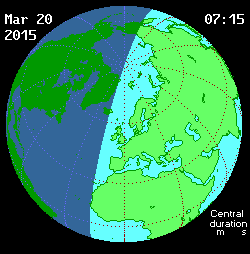
|

|
Eclipse details
[edit]Shown below are two tables displaying details about this particular solar eclipse. The first table outlines times at which the moon's penumbra or umbra attains the specific parameter, and the second table describes various other parameters pertaining to this eclipse.[25]
| Event | Time (UTC) |
|---|---|
| First Penumbral External Contact | 2015 March 20 at 07:41:59.5 UTC |
| First Umbral External Contact | 2015 March 20 at 09:10:40.3 UTC |
| First Central Line | 2015 March 20 at 09:13:50.9 UTC |
| First Umbral Internal Contact | 2015 March 20 at 09:17:19.8 UTC |
| Ecliptic Conjunction | 2015 March 20 at 09:37:18.1 UTC |
| Greatest Duration | 2015 March 20 at 09:46:24.2 UTC |
| Greatest Eclipse | 2015 March 20 at 09:46:46.8 UTC |
| Equatorial Conjunction | 2015 March 20 at 10:18:14.1 UTC |
| Last Umbral Internal Contact | 2015 March 20 at 10:15:51.3 UTC |
| Last Central Line | 2015 March 20 at 10:19:19.7 UTC |
| Last Umbral External Contact | 2015 March 20 at 10:22:29.9 UTC |
| Last Penumbral External Contact | 2015 March 20 at 11:51:20.4 UTC |
| Parameter | Value |
|---|---|
| Eclipse Magnitude | 1.04455 |
| Eclipse Obscuration | 1.09109 |
| Gamma | 0.94536 |
| Sun Right Ascension | 23h58m01.5s |
| Sun Declination | -00°12'50.4" |
| Sun Semi-Diameter | 16'03.7" |
| Sun Equatorial Horizontal Parallax | 08.8" |
| Moon Right Ascension | 23h56m50.5s |
| Moon Declination | +00°42'08.7" |
| Moon Semi-Diameter | 16'41.6" |
| Moon Equatorial Horizontal Parallax | 1°01'15.8" |
| ΔT | 67.7 s |
Eclipse season
[edit]This eclipse is part of an eclipse season, a period, roughly every six months, when eclipses occur. Only two (or occasionally three) eclipse seasons occur each year, and each season lasts about 35 days and repeats just short of six months (173 days) later; thus two full eclipse seasons always occur each year. Either two or three eclipses happen each eclipse season. In the sequence below, each eclipse is separated by a fortnight.
| March 20 Descending node (new moon) |
April 4 Ascending node (full moon) |
|---|---|
 |

|
| Total solar eclipse Solar Saros 120 |
Total lunar eclipse Lunar Saros 132 |
Related eclipses
[edit]Eclipses in 2015
[edit]- A total solar eclipse on March 20.
- A total lunar eclipse on April 4.
- A partial solar eclipse on September 13.
- A total lunar eclipse on September 28.
Metonic
[edit]- Preceded by: Solar eclipse of June 1, 2011
- Followed by: Solar eclipse of January 6, 2019
Tzolkinex
[edit]- Preceded by: Solar eclipse of February 7, 2008
- Followed by: Solar eclipse of April 30, 2022
Half-Saros
[edit]- Preceded by: Lunar eclipse of March 14, 2006
- Followed by: Lunar eclipse of March 25, 2024
Tritos
[edit]- Preceded by: Solar eclipse of April 19, 2004
- Followed by: Solar eclipse of February 17, 2026
Solar Saros 120
[edit]- Preceded by: Solar eclipse of March 9, 1997
- Followed by: Solar eclipse of March 30, 2033
Inex
[edit]- Preceded by: Solar eclipse of April 9, 1986
- Followed by: Solar eclipse of February 28, 2044
Triad
[edit]- Preceded by: Solar eclipse of May 19, 1928
- Followed by: Solar eclipse of January 19, 2102
Solar eclipses of 2015–2018
[edit]This eclipse is a member of a semester series. An eclipse in a semester series of solar eclipses repeats approximately every 177 days and 4 hours (a semester) at alternating nodes of the Moon's orbit.[26]
The partial solar eclipse on July 13, 2018 occurs in the next lunar year eclipse set.
| Solar eclipse series sets from 2015 to 2018 | ||||||
|---|---|---|---|---|---|---|
| Descending node | Ascending node | |||||
| Saros | Map | Gamma | Saros | Map | Gamma | |
120 Totality in Longyearbyen, Svalbard |
March 20, 2015 Total |
0.94536 | 125 Solar Dynamics Observatory |
September 13, 2015  Partial |
−1.10039 | |
130 Balikpapan, Indonesia |
March 9, 2016 Total |
0.26092 | 135 Annularity in L'Étang-Salé, Réunion |
September 1, 2016 Annular |
−0.33301 | |
140 Partial from Buenos Aires, Argentina |
February 26, 2017 Annular |
−0.45780 | 145 Totality in Madras, OR, USA |
August 21, 2017 Total |
0.43671 | |
150 Partial in Olivos, Buenos Aires, Argentina |
February 15, 2018 Partial |
−1.21163 | 155 Partial in Huittinen, Finland |
August 11, 2018 Partial |
1.14758 | |
Saros 120
[edit]This eclipse is a part of Saros series 120, repeating every 18 years, 11 days, and containing 71 events. The series started with a partial solar eclipse on May 27, 933 AD. It contains annular eclipses from August 11, 1059 through April 26, 1492; hybrid eclipses from May 8, 1510 through June 8, 1564; and total eclipses from June 20, 1582 through March 30, 2033. The series ends at member 71 as a partial eclipse on July 7, 2195. Its eclipses are tabulated in three columns; every third eclipse in the same column is one exeligmos apart, so they all cast shadows over approximately the same parts of the Earth.
The longest duration of annularity was produced by member 11 at 6 minutes, 24 seconds on September 11, 1113, and the longest duration of totality was produced by member 60 at 2 minutes, 50 seconds on March 9, 1997. All eclipses in this series occur at the Moon’s descending node of orbit.[27]
| Series members 50–71 occur between 1801 and 2195: | ||
|---|---|---|
| 50 | 51 | 52 |
 November 19, 1816 |
 November 30, 1834 |
 December 11, 1852 |
| 53 | 54 | 55 |
 December 22, 1870 |
 January 1, 1889 |
 January 14, 1907 |
| 56 | 57 | 58 |
 January 24, 1925 |
 February 4, 1943 |
 February 15, 1961 |
| 59 | 60 | 61 |
 February 26, 1979 |
 March 9, 1997 |
 March 20, 2015 |
| 62 | 63 | 64 |
 March 30, 2033 |
 April 11, 2051 |
 April 21, 2069 |
| 65 | 66 | 67 |
 May 2, 2087 |
 May 14, 2105 |
 May 25, 2123 |
| 68 | 69 | 70 |
 June 4, 2141 |
 June 16, 2159 |
 June 26, 2177 |
| 71 | ||
 July 7, 2195 | ||
Metonic series
[edit]The metonic series repeats eclipses every 19 years (6939.69 days), lasting about 5 cycles. Eclipses occur in nearly the same calendar date. In addition, the octon subseries repeats 1/5 of that or every 3.8 years (1387.94 days). All eclipses in this table occur at the Moon's descending node.
| 22 eclipse events between June 1, 2011 and October 24, 2098 | ||||
|---|---|---|---|---|
| May 31–June 1 | March 19–20 | January 5–6 | October 24–25 | August 12–13 |
| 118 | 120 | 122 | 124 | 126 |
 June 1, 2011 |
 March 20, 2015 |
 January 6, 2019 |
 October 25, 2022 |
 August 12, 2026 |
| 128 | 130 | 132 | 134 | 136 |
 June 1, 2030 |
 March 20, 2034 |
 January 5, 2038 |
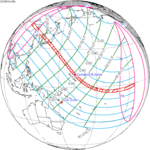 October 25, 2041 |
 August 12, 2045 |
| 138 | 140 | 142 | 144 | 146 |
 May 31, 2049 |
 March 20, 2053 |
 January 5, 2057 |
 October 24, 2060 |
 August 12, 2064 |
| 148 | 150 | 152 | 154 | 156 |
 May 31, 2068 |
 March 19, 2072 |
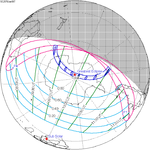 January 6, 2076 |
 October 24, 2079 |
 August 13, 2083 |
| 158 | 160 | 162 | 164 | |
 June 1, 2087 |
 October 24, 2098 | |||
Tritos series
[edit]This eclipse is a part of a tritos cycle, repeating at alternating nodes every 135 synodic months (≈ 3986.63 days, or 11 years minus 1 month). Their appearance and longitude are irregular due to a lack of synchronization with the anomalistic month (period of perigee), but groupings of 3 tritos cycles (≈ 33 years minus 3 months) come close (≈ 434.044 anomalistic months), so eclipses are similar in these groupings.
The partial solar eclipses on March 27, 1884 (part of Saros 108) and December 24, 1916 (part of Saros 111) are also a part of this series but are not included in the table below.
| Series members between 1971 and 2200 | ||||
|---|---|---|---|---|
 July 22, 1971 (Saros 116) |
 June 21, 1982 (Saros 117) |
 May 21, 1993 (Saros 118) |
 April 19, 2004 (Saros 119) |
 March 20, 2015 (Saros 120) |
 February 17, 2026 (Saros 121) |
 January 16, 2037 (Saros 122) |
 December 16, 2047 (Saros 123) |
 November 16, 2058 (Saros 124) |
 October 15, 2069 (Saros 125) |
 September 13, 2080 (Saros 126) |
 August 15, 2091 (Saros 127) |
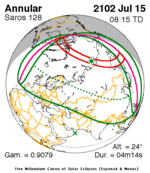 July 15, 2102 (Saros 128) |
 June 13, 2113 (Saros 129) |
 May 14, 2124 (Saros 130) |
 April 13, 2135 (Saros 131) |
 March 12, 2146 (Saros 132) |
 February 9, 2157 (Saros 133) |
 January 10, 2168 (Saros 134) |
 December 9, 2178 (Saros 135) |
 November 8, 2189 (Saros 136) |
 October 9, 2200 (Saros 137) | |||
Inex series
[edit]This eclipse is a part of the long period inex cycle, repeating at alternating nodes, every 358 synodic months (≈ 10,571.95 days, or 29 years minus 20 days). Their appearance and longitude are irregular due to a lack of synchronization with the anomalistic month (period of perigee). However, groupings of 3 inex cycles (≈ 87 years minus 2 months) comes close (≈ 1,151.02 anomalistic months), so eclipses are similar in these groupings.
| Series members between 1801 and 2200 | ||
|---|---|---|
 August 7, 1812 (Saros 113) |
 July 18, 1841 (Saros 114) |
 June 28, 1870 (Saros 115) |
 June 8, 1899 (Saros 116) |
 May 19, 1928 (Saros 117) |
 April 30, 1957 (Saros 118) |
 April 9, 1986 (Saros 119) |
 March 20, 2015 (Saros 120) |
 February 28, 2044 (Saros 121) |
 February 7, 2073 (Saros 122) |
 January 19, 2102 (Saros 123) |
 December 30, 2130 (Saros 124) |
 December 9, 2159 (Saros 125) |
 November 18, 2188 (Saros 126) |
|
References
[edit]- ^ "March 20, 2015 Total Solar Eclipse". timeanddate. Retrieved 12 August 2024.
- ^ "Moon Distances for London, United Kingdom, England". timeanddate. Retrieved 12 August 2024.
- ^ F. Espenak & Xavier Jubier. "NASA - Total Solar Eclipse of 2026 August 12". Retrieved 20 March 2015.
- ^ "Solar eclipse 2015 live: Britain to plunge into morning twilight as Moon blocks out Sun". Daily Telegraph. 20 March 2015. Retrieved 20 March 2015.
- ^ "Solar Eclipse: live updates". Guardian. 20 March 2015. Retrieved 20 March 2015.
- ^ Rao, Joe (20 March 2015). "Flight to Totality: How I Chased the Total Solar Eclipse of 2015 on a Jet". space.com. Retrieved 21 August 2017.
- ^ "Solar eclipse as seen by a radio telescope". 20 March 2015. Retrieved 20 March 2015.
- ^ "EUMETSAT case study". 20 March 2015. Archived from the original on 2 April 2015. Retrieved 24 March 2015.
- ^ "Meteosat-10 video of the eclipse". YouTube. 20 March 2015. Archived from the original on 2021-12-20. Retrieved 24 March 2015.
- ^ Eckert, Vera (20 March 2015). "European power grids keep lights on through solar eclipse". reuters.com.
- ^ Solar Eclipse March 2015 Policy Brief European Network of Transmission System Operators for Electricity, 15 July 2015
- ^ "Solar Eclipse 2015 – Impact Analysis" pp3+6+7+13 . European Network of Transmission System Operators for Electricity, 19 February 2015. Accessed: 4 March 2015.
- ^ "Curve of potential power loss". ing.dk. Archived from the original on 22 March 2015.
- ^ "Total Solar Eclipse on March 20, 2015: Path Map and Times". www.timeanddate.com. Retrieved 2024-04-28.
- ^ Hanna, Edward; Penman, John; Jónsson, Trausti; Bigg, Grant R.; Björnsson, Halldór; Sjúrðarson, Sølvi; Hansen, Mads A.; Cappelen, John; Bryant, Robert G. (2016-09-28). "Meteorological effects of the solar eclipse of 20 March 2015: analysis of UK Met Office automatic weather station data and comparison with automatic weather station data from the Faroes and Iceland". Philosophical Transactions of the Royal Society A: Mathematical, Physical and Engineering Sciences. 374 (2077): 20150212. Bibcode:2016RSPTA.37450212H. doi:10.1098/rsta.2015.0212. ISSN 1364-503X. PMC 5004046. PMID 27550769.
- ^ McClure, Bruce (8 March 2015). "In 2015, first of six supermoons comes on January 20". EarthSky. Retrieved 20 March 2015.
- ^ Weisz, Tuly (12 March 2015). "Passover Blood Moon Preceded by Exceedingly Rare Solar Eclipse". breakingisraelnews.com.
- ^ Borschel-Dan, Amanda (19 March 2015). "Solar eclipse Friday has some looking for signs from God". Times of Israel.
- ^ Weisz, Tuly (22 March 2015). "Blood Moon Enthusiasts Show Total Enthusiasm for Jerusalem's Partial Eclipse". breakingisraelnews.com.
- ^ Webb, Jonathan; Amos, Jonathan (20 March 2015). "'Breathtaking' solar eclipse witnessed by millions". BBC News.
- ^ Ahlstrom, Dick; Siggins, Lorna (20 March 2015). "Solar eclipse 2015: Brief glimpses as clouds hide spectacle". Irish Times.
- ^ "Thick cloud hides solar eclipse in France". thelocal.fr. 20 March 2015.
- ^ "Partial solar eclipse over Germany". www.mpg.de. 20 March 2015.
- ^ "Solar eclipse over Poland". thenews.pl. 20 March 2015.
- ^ "Total Solar Eclipse of 2015 Mar 20". EclipseWise.com. Retrieved 12 August 2024.
- ^ van Gent, R.H. "Solar- and Lunar-Eclipse Predictions from Antiquity to the Present". A Catalogue of Eclipse Cycles. Utrecht University. Retrieved 6 October 2018.
- ^ "NASA - Catalog of Solar Eclipses of Saros 120". eclipse.gsfc.nasa.gov.
Bibliography
[edit]- NASA graphics
- Google interactive map of the eclipse from NASA
- NASA Besselian Elements – Partial Solar Eclipse of 2007 September 11
External links
[edit]- Northern Equinox Eclipse, APOD 3/21/2015, totality of Longyearbyen, Svalbald
- A Double Eclipse of the Sun, International Space Station moving in front of the eclipsed sun, APOD 3/22/2015, partial eclipse of Fregenal de la Sierra, Spain
- Diamond Rings and Baily's Beads, APOD 3/28/2015, totality of Longyearbyen, Svalbald
- Corona from Svalbard, APOD 3/31/2015
- Centered and aligned video recording of full phase of total solar eclipse on YouTube
- Eclipse spectacle AstroBob, 3/20/15
- A Full time-lapse taken by UK resident Roger Skillin in Iceland where it was 97.3% totality on YouTube




